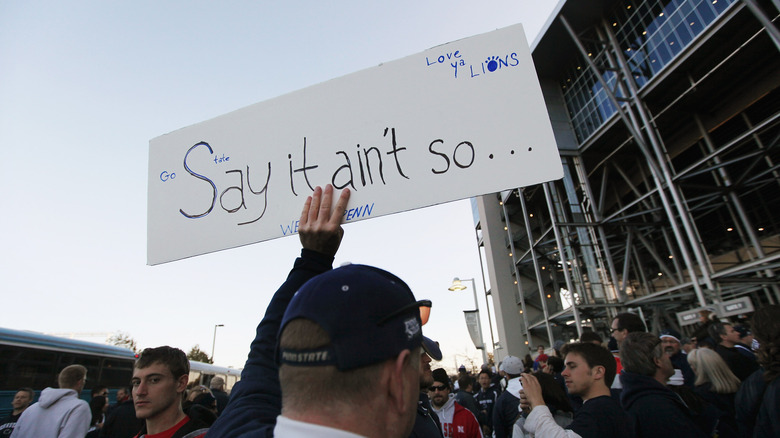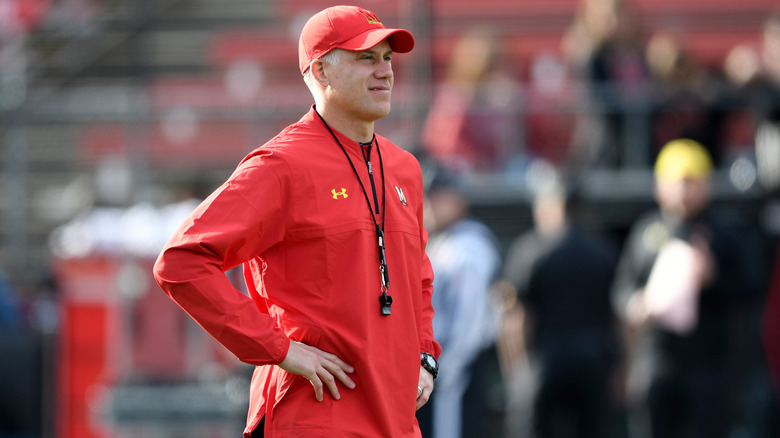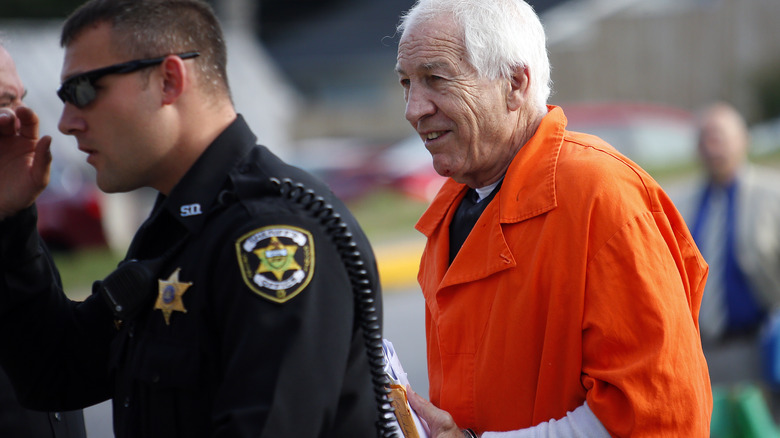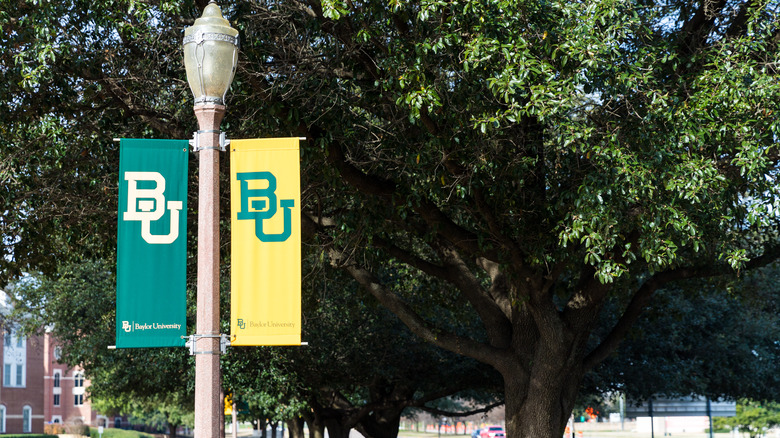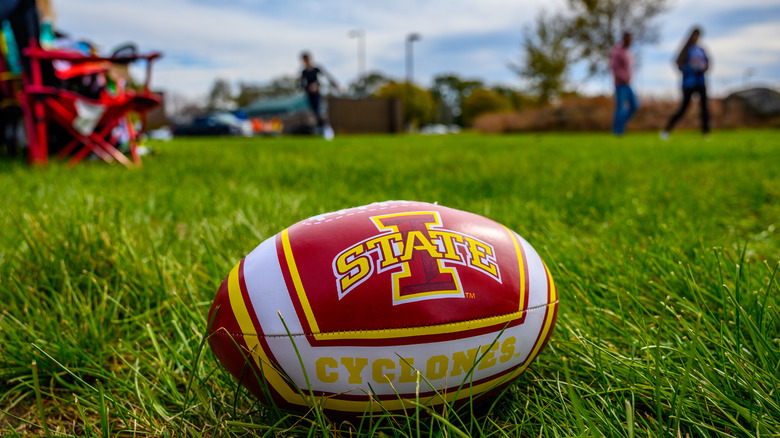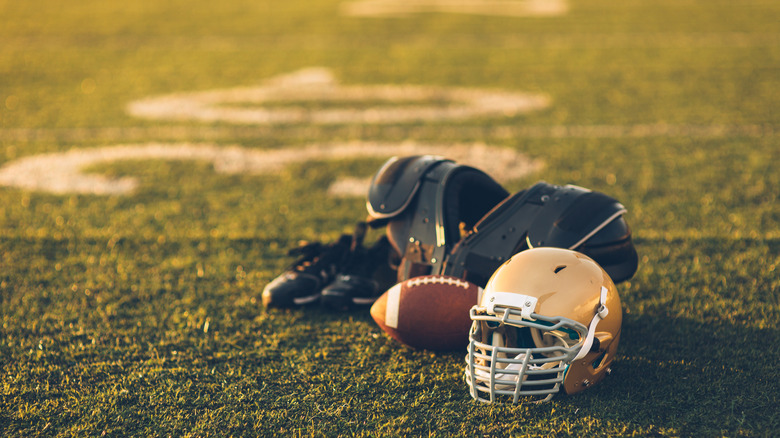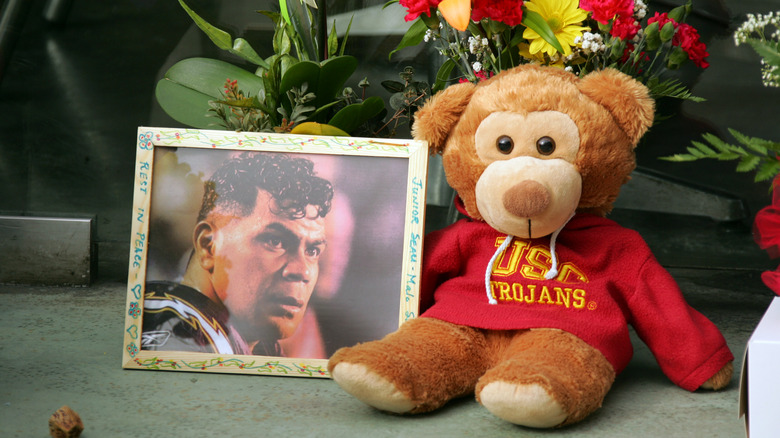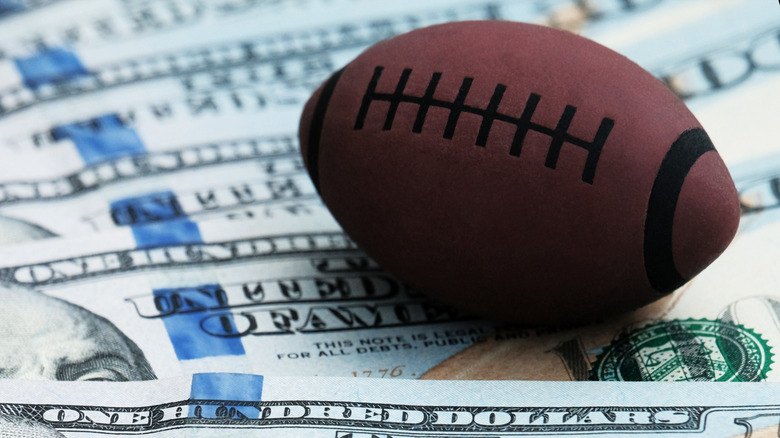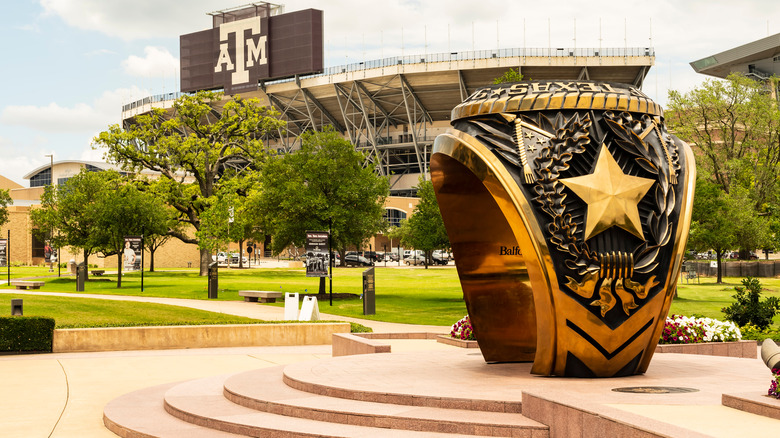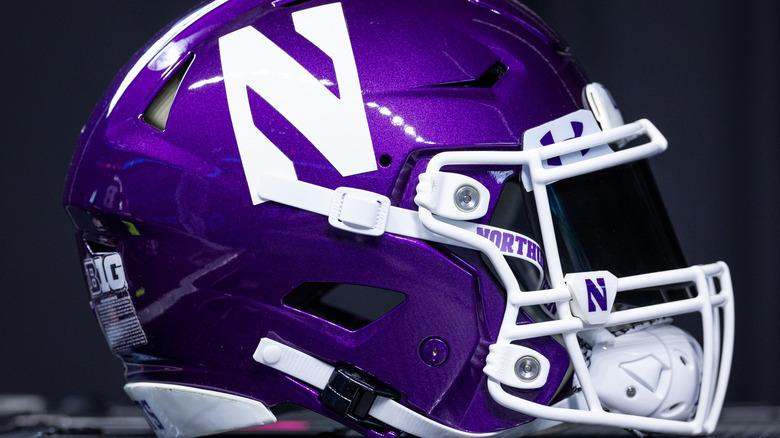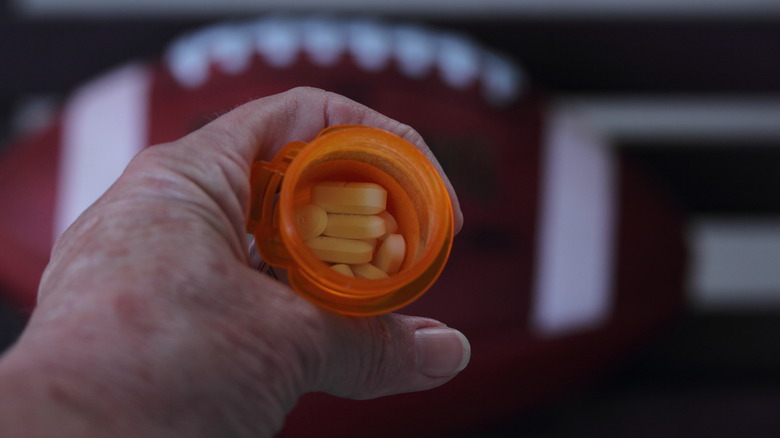Sketchy Things About College Football
Ask any student or former student who went to a college where the football team's colors hung around the campus for the months-long season, and it'll quickly become clear just how important college football is. Alumni cheer their team on long after graduating, and while professors, classes, and entire campuses might change, football remains.
And here's the thing — it almost didn't. Early college football was so brutal that there were scores of people who wanted it outlawed altogether. These were the days when one of the most fundamental plays — the forward pass — was actually illegal, and games often led to gruesome injuries and even more gruesome deaths. Those games were given nicknames like "the bloodbath at Hampden Park," and one season — 1905 — was called the "death harvest."
It was then-President Teddy Roosevelt who called for a massive overhaul of the sport, telling colleges that they needed to find a way to make it safer and not-so-deadly... while also stressing that they needed to make it not "too ladylike." (His interest may have had something with the fact that his son had his nose broken in a game while playing for Harvard.) That led to a massive series of sweeping changes, and while it may have made the game safer, it didn't lead to a scandal-free sport. On the contrary, college football has some seriously shady, sketchy things lurking behind those bright colors.
It's surprisingly deadly, even off the field
Deadly? Quite. In an analysis of college football deaths, The Howard Center found that between 2000 and 2021, 22 players died — and that's just in Division I. Furthermore, they add that only a single head coach — D.J. Durkin (pictured) — was fired after the death of a player. (He was fired from Maryland, and later hired by Mississippi.)
Stories are as heartbreaking as they are plentiful. Ted Agu was 21 years old when he collapsed during sprinting drills at the University of California, Berkeley, and his cause of death was changed from cardiac arrest to collapse from sickle cell. Marquese Meadow was hospitalized for two weeks after participating in what was deemed a "punishment practice" for Meadow State University. He suffered heatstroke: So did Tyler Heintz, a 19-year-old who died at Kent State University in 2017, 18-year-old Eraste Autin (University of Florida), and Jordan McNair, who died at the University of Maryland in 2018. Devaughn Darling, Aaron Richardson, Dale Lloyd II, and Ereck Plancher — among others — died from complications relating to sickle cell.
Others come close. In 2011, The Gazette reported that 13 University of Iowa players were hospitalized after a grueling practice left them suffering from rhabdomyolysis, a condition that disrupts kidney function. By 2018, their strength and conditioning coach, Chris Doyle, remained the highest-paid in the league, with an annual salary of $725,000. Douglas Casa, CEO of the University of Connecticut's Korey Stringer Institute, observed, "It's a travesty that we allow these big-time college programs to abuse these athletes."
Coaches have often been accused of abusing players and other students
In 2020, three former college students filed a sexual harassment and assault lawsuit not only against their former coach, but also against the NCAA. The volleyball and track and field athletes said that not only were they assaulted repeatedly by their coach, but claimed (via Courthouse News) that the NCAA didn't have enough laws in place to provide protection against such assaults — and it's a problem that extends to football.
In 2021, The Washington Post reported on a shocking case that saw more than 950 people forward to accuse University of Michigan team doctor Robert E. Anderson of sexual abuse between 1966 and 2003. Many of those who came forward were former football players, but students from a variety of teams were included in the claims. (Anderson died in 2008 before any formal charges were brought). That came just a few years after Ohio State's team doctor, Richard Strauss, was accused of similar offenses against 177 students, and according to official documents, the school was also named as being complicit. The report stated that "Many of the students felt that Strauss's behavior was an 'open secret,'..."
And most famous was perhaps the Penn State sex abuse scandal, where defensive coordinator Jerry Sandusky (pictured) was found guilty of the sexual abuse of 10 victims over the course of more than a decade. Also named were Penn State officials, who were accused of covering up the abuse.
Colleges have been accused of ignoring accusations of sexual assault
In 2016, ESPN's Outside the Lines spoke to a former Baylor University student they identified only as Tanya. When she was sexually assaulted, she reported the rape to her college, to Waco police, and to hospital staff who examined her. Later, when she requested security and counseling services, she said, "They didn't just not respond; they responded by turning me away and telling me that it was not possible for me to receive help from them."
The outlet did their own investigation into how colleges across the country handled reports of sexual assault, and found there were 161 that were being investigated by the U.S. Department of Education for their actions. Not all involved football players, but plenty have — and Baylor had another shady mark on their record, when they dealt with a 2013 incident by clearing defensive end Sam Ukwuachu of wrongdoing after a soccer player reported an assault.
Similar cases continue to surface. In 2020, USA Today reported finding that for years, LSU buried complaints of assault filed against players that included running back Derrius Guice, and wide receiver Drake Davis. And in 2021, Marissa Root came forward with accusations that when she reported being raped by a University of Utah football player in 2019, (via KSL TV) she was "dissuaded ... from filing an official complaint." Root added, "They didn't ask me his name. They should have been very concerned that their campus might not be safe for other people."
If you or anyone you know has been a victim of sexual assault, help is available. Visit the Rape, Abuse & Incest National Network website or contact RAINN's National Helpline at 1-800-656-HOPE (4673).
Betting scandals aren't unheard of
Student athletes are privy to all kinds of information that might give someone an advantage when it comes to wagering on games. What's a lineup looking like, what's the status of some key injuries... and, of course, when they're playing, they have the ability to make a key fumble or miss a pass. There are a ton of reasons why those in-the-know aren't supposed to be betting on their own games, but it still happens. In 2023, seven people associated with the Iowa State football team — including four players and three staffers — were charged with placing bets on games they played in.
According to ESPN, they weren't small bets, either, with running back Jirehl Brock charged with making 1,327 bets worth more than $12,000. According to a report by The Associated Press, it's only gotten easier with the advent of online gambling and apps.
In an effort to stop players from betting on the games that they're in, companies like U.S. Integrity are hired to monitor betting organizations using a database of player information that includes things like birthdays, cell phone numbers, and other key pieces of personal information that can link players with accounts — or accounts of family members. And no, Iowa State isn't the only college being investigated. Between the establishment of the NCAA's sports betting policies in 2018 and 2023, 175 violations had been logged.
Academic misconduct scandals pop up a lot
In 2017, The New York Times took an in-depth look at Florida State University's 2013/14 academic fraud scandal. It started when teaching assistant Christina Suggs issued formal complaints with the school, saying that she had been pressured to give football players special considerations that included overlooking plagiarized papers and handing out grades that weren't earned.
They're far from the only school to be implicated in committing academic fraud. In 2013, Sports Illustrated reported speaking to 13 Oklahoma State football players who had come forward to say they had been part of some kind of fraud, including having others do their work for them, or just being handed passing grades. In 2016, Georgia Southern had a series of wins reversed after it was found players had taken the field thanks to academic fraud, and the University of Notre Dame found itself facing similar sanctions the same year. And strangely, in 2017 it was announced that the University of North Carolina would not be penalized for organizing decades of fake classes, as they hadn't technically broken any rules.
Speaking to Inside Higher Ed, Ohio University professor of sports administration David Ridpath described academic fraud as "an epidemic and a problem that will continue until faculty take control of their campuses." And it's had devastating consequences. Christina Suggs's friends and family spoke to the Times about the impact it had on her: When she died in 2014, the official cause was a combination of medications prescribed for chronic depression, anxiety, and pain.
Concerns over head injuries have reached the NCAA, too
A lawsuit filed against the University of Southern California had the potential to be groundbreaking. It was filed by Alana Gee after the death of her husband, Matthew. He had been a USC linebacker in the 1990s, suffered from permanent brain damage, and was one of five teammates who died before they reached the age of 50. (One of his teammates was Junior Seau, pictured in a memorial.)
The lawsuit claimed that the school knew of the dangers of repeated head trauma, and that by 2013, Gee had begun to struggle with memory loss, confusion, and depression, as a result of his time on the field. The lawsuit read (in part, via The Associated Press), "For years, (the NCAA) has kept players like Matthew Gee and the public in the dark about an epidemic that was slowly killing college athletes."
The case went to trial, and the NCAA was found to be not liable for Gee's death. Experts suggested that the verdict would give colleges the advantage when other cases came up, but it's still not a clear-cut matter. Medical evidence is building up, and in 2022, a sprawling study of 447 former college football players was published in the Journal of the American Medical Association. They found players were at a higher risk of developing "cognitive impairment disorders, recurrent headaches, cardiovascular disease, and hypercholesterolemia" than the average male population.
There have been some shady deals made in the name of money
It goes without saying that football and money go hand in hand, and when a bizarre case went to trial in 2019, it quickly became clear just how close those two things are. At the heart of it was Louis Martin Blazer, who had been arrested for embezzlement in 2014. That's also when he made a deal with the FBI to go undercover and investigate corruption in college basketball, and it was an operation that quickly expanded to football, too.
In a nutshell, Blazer would issue payments — generally between $100 and $3,000 per month — to accounts associated with various players. Then, when the player in question turned pro, Blazer could be assured of getting them as a client for his money management services. According to The Washington Post, he also testified on the stand that he had also acted on behalf of coaches who, for example, didn't want star players jumping into the NFL too soon. Blazer claimed that he would give family members money in return for a little persuasion to stay in college a little while longer.
Blazer was ultimately given probation and ordered to pay restitution, but he also suggested that he was just the tip of the iceberg. He testified, "I wasn't the only one paying them. There were other agents involved." Schools named in the courtroom included North Carolina, Northwestern, and Penn State, with schools vowing to investigate the accusations internally.
Not everyone is happy with NIL deals
NIL deals, or Name Image Likeness deals, were instituted as a way to allow college athletes to make some money off their, well, names, images, and likenesses. In other words, they can sign sponsorship deals and sell autographs, while still keeping scholarships.
Once it was put into practice, though, it turned out to be pretty controversial. It wasn't long before some coaches (like Alabama's Nick Saban) were calling out other teams (like Texas A&M) for relying on huge NILs to lure players to the school. Naysayers cited wealthy donors funding lucrative deals to put on the recruiting table, and when NBC did a deep dive into exactly what those deals were, they found that some included some sketchy things.
They found that although NIL deals had been approved, actual guidelines were lacking — and that had resulted in contracts that their legal team deemed "exploitative," particularly considering that many were being offered to high school students. And that was all in line with findings published by Sports Illustrated, which also reported that high-level boosters were supplying the cash to attract players. Hugh Hathcock donated $1 million to the University of Florida, saying, "The landscape is, if we don't get the money, we're going to lose players. No matter how well a kid likes Florida, if a school comes in at the last minute and says, 'We are going to pay you $100,000,' and we have $10,000, they're gone."
Coaches are hesitant to name names in tampering, but hate it
It's not uncommon for college students to switch schools, and there are a number of reasons for it. College football's transfer portal is a legit way to allow athletes to essentially put themselves out there as a free agent, but coaches have said that there's a huge problem with it: Some schools are accused of ignoring it completely, and reaching out to students with offers while they're still sitting comfortably on their team's roster.
ESPN took a look at the practice in 2021 and found that most coaches viewed the practice as cheating — not only was it poaching the best players for their own teams, but it was leaving other teams to scramble to try to fill positions that they thought were secure. They also found students who hadn't even been considering putting their names into the transfer portal until they started getting calls from other interested colleges, sometimes via their old high school coaches.
Stanford coach David Shaw says, "To go behind another coach's back and recruit somebody on their roster... I think it's disgusting." When CBS looked into the practice in 2023, they found many coaches weren't willing to name names: The University of Texas at San Antonio coach Jeff Traylor and Texas Christian University coach Sonny Dykes were among those that explained why, calling it a practice that was hard to trace, hard to prove, and harder to stop.
Athletes report hazing is still common
When Ramon Diaz spoke about his experience as an offensive lineman at Northwestern University, he said (via CNN): "My experience playing football at Northwest[ern] University haunts me to this day. I never will forget the mistreatment that I experienced for those four years." It was 2023, and Diaz had left the team in 2008. He became one of a handful of students who stepped forward to paint an awful picture of teammates who were — according to a lawsuit — "forced to conform to a culture of abuse, racial discrimination, bigotry, and sexual exploitation."
The team's head coach was fired amid the allegations, and it wasn't the only school to have students come forward with accounts of hazing. For example, USA Today reported on a hazing scandal that hit the University of San Diego in 2023, and led to around half the team being named and suspended as either active or passive participants. While they said no one was physically injured, that hasn't been the case in all reported incidents. In 2017, five Wheaton College football players were charged in a hazing incident that The New York Times reported had involved an abduction, attempted sexual assault, and a beating that left the victim with injuries that required surgery.
Expert psychologist Susan Lipkins told the Associated Press that reports are increasing in "frequency and severity, and in sexuality." That makes it even more surprising that the NCAA does not, in 2023, have rules against it.
The impact of opioid prescriptions is unclear
In 2020, Sports Health published the findings of joint research from McMaster University and the University of Toronto, looking at opioid use and abuse in athletes. They found statistics suggested that football players and wrestlers were at "significantly higher risk of nonmedical use of opioids compared with other sports."
And those most closely impacted by it have started telling their stories. In 2019, one of the people taking the stand in a trial accusing Johnson & Johnson of enabling the opioid crisis was Craig Box. His son, Austin, was a linebacker for the University of Oklahoma, who died in 2011. The cause? Painkiller abuse. Box testified (via Reuters) that they had been marketed to his son as safe when they clearly hadn't been. In 2020, Rice University football player Stuart Mouchantaf pleaded guilty to charges relating to the 2018 death of teammate Blain Padgett, who had passed away after being given Carfentanil.
Some have spoken openly about overcoming addiction, too. Jacob Jones played for the University of Alabama when he started taking painkillers for torn muscles. He was in and out of rehab before things got really, really bad: "It was to the point that when I went to stop, I was hospitalized for a week. My resting heart rate was at stroke level. I spent a week in the critical coronary unit and from there, three weeks in a psych ward." When he was interviewed by WUFT, he had been clean for two and a half years.
If you or anyone you know needs help with addiction issues, help is available. Visit the Substance Abuse and Mental Health Services Administration website or contact SAMHSA's National Helpline at 1-800-662-HELP (4357).
